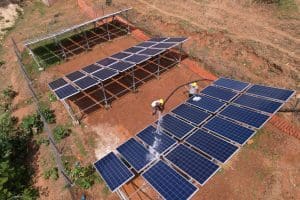
Today’s airports are a gateway to a connected world, built as an autonomous society. They are now seen as a smart city where many processes are digitized, including pre-construction planning and construction management in 5D (with the addition of the dimensions of cost and time to 3D). As they become increasingly complex in operations, the challenges faced by airports have become more demanding, from security to passenger experience to operational efficiency to sustainability. Using the latest digital technologies will go a long way in addressing the challenges of construction, lowered carbon emissions, greater revenues, and providing excellent passenger experience.
Recently, I moderated a webinar ‘Airports of Tomorrow’ that brought industry leaders Daniel Bircher, CEO, Zurich Airport International Asia (Kuala Lumpur); Hari K. Marar, Managing Director & Chief Executive Office, BIAL; and Anil Chaudhry, CEO SEIPL and Zone President, Schneider Electric India together on one platform. We discussed ideas for building India’s ‘future ready’ airports – Airports 4.0. We are experiencing ever-changing trends in air travel, requiring rapid adaptation of airport infrastructures. Climate change and rising CO2 emissions is one of the most urgent changes facing the world today. Airports of Tomorrow require carbon neutrality and a sustainable system.
The discussion looked at effective use of renewable energy sources to power airport facilities, optimising energy efficiency to minimise operating costs and, ultimately, to achieve carbon neutrality. The global aviation industry contributes about 2% of global carbon emissions. With such a massive carbon footprint, the entire aviation sector is strongly committed to lowering carbon emissions and effectively managing overall energy use. An added benefit would be that airports will dramatically save on energy costs.
Energy use at airports contributes significantly to global carbon emissions, and airports are, rightly, considering replacement or reduction of fossil energy consumption. It is also essential, however, to consider other elements of airport operations that have an impact on the environment. For example, airports generate large amounts of waste, and it is, therefore, important to ensure that airports manage and dispose of their wastes in the most sustainable way possible. There are many innovations – technologies and processes – that enable conversion of certain types of waste material into energy. Another area that airports need to be concerned about is the usage of water for various processes and passenger convenience. Thus, airports need to ensure that all resources used, not only energy, are better managed to reduce their overall impact on the environment.
The goal for Airports 4.0 can be achieved by ensuring resource efficiency with unmatched passenger experience and safety. The solution is extensive digitisation of the entire value chain of airport infrastructure management, which helps create a better experience, ensuring that customers are served seamlessly and sustainably. Connecting all departments, which work in their own separate silos, will provide an integrated framework which enables ‘one version of reality’ . This holistic view further enables quicker decision making, better controls, improved operating efficiency and the opportunity to offer travelers a seamless experience.
As the world becomes more digital, investments in digital processes and technology will allow airports not only to generate strong revenue streams, but also to develop more decarbonized, decentralised and sustainable infrastructure. Automation and big data will make our airports more sustainable and robust.




